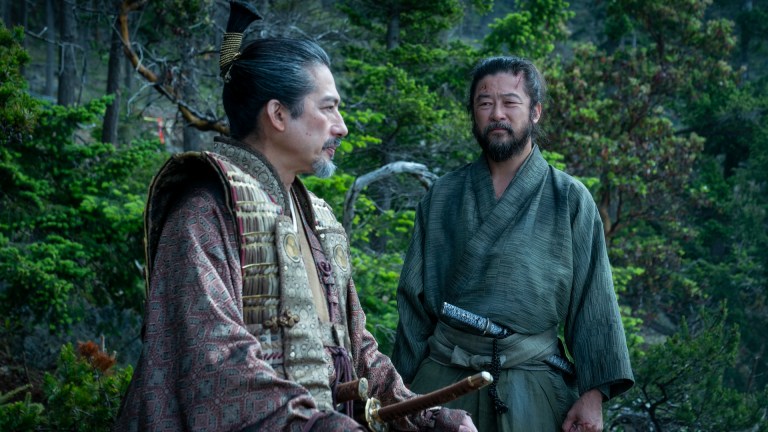Shogun Ending Explained: Does Episode 10 Set Up Season 2?
FX's Shogun may not be getting a second season but the finale makes clear that the story doesn't end here.

This article contains spoilers for Shogun episode 10.
The characters of FX’s Shōgun know all about endings. After John Blackthorne (Cosmo Jarvis) experiences the first of many Japanese earthquakes in the miniseries’ fourth episode, his translator/lover Mariko (Anna Sawai) explains how her people have come to adapt to the environmental instability.
“It is why our houses are built to go up as quickly as they come down,” she says. “Because death is in our air. And sea and earth. It can come for us at any moment. Before you meddle with our politics, just remember … we live and we die. We control nothing beyond that.”
While Mariko-sama is right that a person can control nothing beyond living and dying, it turns out that one individual living or dying is enough to change everything. Mariko helped establish the future with her sacrifice in Shōgun‘s penultimate episode. Now it’s up to the 10th and final episode, “A Dream of a Dream,” to make sure that sacrifice was not in vain.
Here is how Shōgun‘s story ends, what it means for the future of the surviving characters, and why their likely won’t be a season 2.
Who Destroyed Blackthorne’s Ship?
While the Shōgun finale is mostly about answers, it does introduce one new question early on in its proceedings. After Blackthorne finally makes it back to Ajiro, he discovers that his beloved boat The Erasmus has been destroyed, ending his hopes of establishing an English trade route to Japan – or ever leaving Japan at all. So who would do such a thing?
According to Toranaga (Hiroyuki Sanada), it was the “Christians” who stormed the fishing village and sank the Erasmus. While that’s partially true, it doesn’t tell the whole story. As Blackthorne himself works out, Mariko made a deal with her Catholic allies to spare Blackthorne’s life in exchange for access to Ajiro to destroy his boat, which could be used against the Catholics in wartime. As co-showrunner Justin Marks puts it in episode 10 of the Shōgun companion podcast, the deal is to “save the man but take the weapon out of his hands.”
What Blackthorne doesn’t realize, however, is that Mariko didn’t cut that deal with the Portuguese on her own. She did so with the full blessing of Toranaga. Everybody gets what they want here. Mariko is (posthumously) happy that Blackthorne gets to live. The Portuguese are happy that a threat to them is off the board. And Toranaga is happy that he will have secured the loyalty of a man who can build him not just one boat, but a whole fleet of them.
“It was a necessary ruse to test the Anjin,” Toranaga later tells Yabushige (Tadanobu Asano).
Could not load Embed Code for Riddle I1m0NYeF: Request failed: HTTP 403: API_AUTHENTICATION_FAILED: Could not not authenticate with the Riddle API. Please check if the credentials you sent match with the ones provided on riddle.com (Endpoint: api/riddle/embed-code/I1m0NYeF).What Was “Crimson Sky” Really?
Speaking of Toranaga, if there is one thing to take away from this episode it’s that the humble falconer might just be the most ingenious, impressive, and incredible human being who has ever lived. Even the barbarian understands as much. After Father Martin Alvito (Tommy Bastow) muses to Blackthorne that he believes Toranaga will be dead in weeks, Blackthorne responds “Then you do not know Yoshii Toranaga.”
Toranaga gets everything he wanted out of this conflict with the Council of Regents: the hostages in Osaka are free, Lady Ochiba has agreed to not call the Taiko’s banners to Ishido’s cause, and he’s ready to build his new world in Edo. All it cost was the life of one woman … but what a bonfire she made in the process.
So how much of this victory was by Lord Toranaga’s grand design and how much of it came down to blind luck? Was sending Mariko to defeat Osaka rather an army what “Crimson Sky” meant this whole time? To answer that last question first: yes, what we just witnessed was Crimson Sky. Toranaga tells Yabushige as much before Yabushige is compelled to commit seppuku: “Crimson Sky is finished.”
In hindsight, Toranaga and Hiromatsu’s original conception of Crimson Sky felt uncommonly inelegant for the scheming lord. That’s because, as described, it essentially just amounted to a Leroy Jenkins-style rush against the heavily fortified castles of Osaka. If that ever was part of Toranaga’s plans, it certainly wasn’t anymore after an earthquake devastated his army. With the regents united, he could never make a move on Osaka, so he “sent a woman to do what an army never could.”
With her simple act of defiance, Mariko laid bare the dysfunction and distrust at the center of the Council of Regents. She also convinced Lady Ochiba to keep the heir’s army out of the battle to come, all but ensuring victory for Toranaga’s forces. According to historian Frederik Cryns on the aforementioned Shōgun podcast, much of this occurred in the real Japanese history that the show borrows from.
“The unity of the court was not great,” Cryns explained. “It really started to crumble as soon as hostilities started. Yodo-no-Kata [the real life version of Ochiba] eventually didn’t side with Mitsunari [the real life version of Ishido]. The letter of Ochiba does exist in real life. Yodo-no-Kata also sent a letter to Ieyasu [the real life version of Toranaga] that Mitsunari was plotting. The heir was not on the side of Mitsunari.”
Like the viewer surely is, Yabushige is properly stunned by all of the brilliant scheming Toranaga has put into place to become the next shōgun in Japanese history. But Toranaga assures Yabu that he doesn’t create the wind, he only studies it. And thanks to what happens next, we all know which way the wind is blowing.
What Happens Next?
We opened this piece by saying that Shōgun is all about endings. While true, that sentiment leaves out just how much Shōgun is about beginnings as well. That’s because the series takes place in 1600, right on the precipice of Japan’s most notable era: The Edo Period.
Everything that Toranaga has done up until this point hasn’t been solely for his and his people’s survival but for the betterment of Japan as a nation through the establishment of his shogunate. Toranaga is seeking to bypass the stale history of Osaka by creating a new hub of culture and peace in his land that will come to be known as Edo (and later on Tokyo).
While we don’t know precisely what will happen next to the surviving characters we’ve come to know and love, we do know that the future looks pretty bright thanks to the incoming Edo era. The Shōgun podcast has a good breakdown of what to expect from it:
“The Edo Period was an era of peace and prosperity in a country that had been plagued by civil wars for hundreds of years. But with the growth came the tightening of class ranks and the introduction of a feudal system that restricted class mobility. Men like Ishido or the Taiko who were born into lower castes would never climb the ranks of power. Tokugawa also closed Japan to all foreigners, only maintaining one port for foreign trade. As a result of these trade restrictions, regions of the country began to specialize in everything from tea to textiles. It was a time of invention, art, and urbanization. By the early 18th century, Edo was the largest city in the world.”
Did John Blackthorne Ever Leave Japan?
“Dream of a Dream” seemingly opens with a flashforward in which an ancient John Blackthorne convalesces in a bed in an English manor as his grandchildren talk about their grandfather’s adventures in Japan. Of course, this is the “dream of a dream” that the episode’s title refers to as it will never come to pass.
Marks explained on the podcast: “We wanted to open this episode with what feels like the beginning of a flashback structure where we jump forward into the future where Blackthorne is an old man looking back with regret on the life that he led – only to realize that was not the dream of an old man looking back, it was the dream of a young man looking forward to one possible version of his life.”
That dream ends when Blackthorne makes the decision to attempt suicide to protest Toranaga’s treatment of the villagers. At that point he truly accepts that he will live and/or die in what was once a strange land. Toranaga later tells Yabushige that “I don’t think it’s his fate to ever leave Japan” and Toranaga is right. The real life William Adams never left Japan. And based on the fact that Blackthorne gifted Mariko’s cross to the waters off Ajiro, he never will either.
Will There Be a Shogun Season 2?
In the modern TV era, sometimes networks and streamers can be cagey about whether a new show should be categorized a traditional TV series with the potential for future seasons or a closed “miniseries.” FX has not expressed any such misgivings when it comes to Shōgun. Every step of the way – from conception to announcement to production to marketing to airing – Shōgun has always been described as a miniseries.
James Clavell’s 1975 book upon which Shōgun is based tells a complete story with a beginning, middle, and end. As does the 1980 miniseries adaptation for NBC. The story of Toranaga, Blackthorne, Mariko, and company is complete.
There is, however, one way in which a Shōgun season 2 might make sense. Including Shōgun, Clavell wrote six books that take place in various historical periods across Asia. Known as the “Asian Saga,” these six stories feature occasional crossovers with one another despite occupying different countries and eras. One of these books, Gai-Jin, takes place in 1860s Japan and even features a descendant of Lord Toranaga.
Should FX one day decide to commission an adaptation of Gai-Jin, they may conclude that branding akin to Shōgun: The Next Generation is in order.
For what it’s worth, Shōgun showrunners don’t seem to be fundamentally opposed to a second season of the series in one way or another. In an interview with The Hollywood Reporter, Justin Marks and Rachel Kondo acknowledged the storytelling possibilities that Clavell’s Asian Saga novels represent.
“I keep saying it’s like we want to let everyone be on the same page when it comes to the book,” Marks said. “And hopefully now the TV audience and the book audience are on the same page with what the story is and where it resolves. I think if we had a story, if we could find a story, we would be open to it. But I don’t think that anyone ever wants to be out over their skis without a roadmap and everything.”
All 10 episodes of Shōgun are available to stream on Hulu and Disney+ now.
